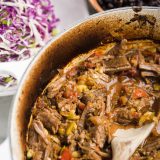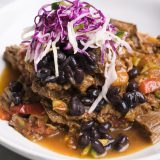Flank steak can be finicky, prone to toughness if over- or undercooked. Cuban cooks have a solution. They braise it, then combine the meat with a rich, tomatoey sauce laced with bell peppers and onions. The tender beef often comes studded with roasted peppers and briny green olives or capers.
The dish, ropa vieja, originally derived from a Spanish stew built on chickpeas and cheap cuts of meat. The leftover meat—simmered for hours—was then shredded and sautéed with garlic, onions and, in later years, tomatoes and peppers. Spanish colonists first brought the multiday meal to the Canary Islands, where it still includes chickpeas. Canarian immigrants in turn brought the recipe to Cuba and other parts of the Caribbean in the 1800s.
Traditional recipes call for braising flank steak in water or stock until tender, then separately making a sofrito—a flavorful cumin- and oregano-tinged reduction of garlic, onions and sweet peppers. Tomato paste and dry red wine are often stirred into the sofrito, as is a portion of the beef’s cooking liquid. After hours of cooking both, the shredded meat is added to the sauce.
We loved ropa vieja’s deep flavors, but we wanted to streamline its preparation as much as possible. So we consolidated the beef and the sauce in one pot, allowing them to cook together. We also increased the ratio of vegetables to beef, so the final braise would be more balanced.
After toasting cumin and coriander seeds, we sautéed onions, bell peppers and garlic with the spices. We also added jalapeños to lend the dish gentle heat. And instead of typical tomato paste, we opted for the fresher, brighter flavor of canned whole tomatoes. After the vegetables browned and the sauce reduced, we nestled the meat into the mixture.
While many recipes call for enough liquid to submerge the steak, we used only a cup of beef broth (water works perfectly fine, as well). And instead of leaving the pot on the stovetop, we transferred it to the oven, which cooked the meat more evenly. Two hours covered and one uncovered tenderized and browned the beef. And because we used less liquid, the resulting sauce had meatier, more concentrated flavor.
Rather than remove the meat from the sauce and shred it on a cutting board, we used kitchen shears to snip For a briny-acidic finish, we tossed in green olives and lime juice. The result was tender and succulent, hearty yet distinct—a balanced approach to a Cuban classic.





